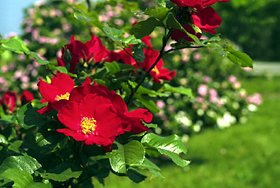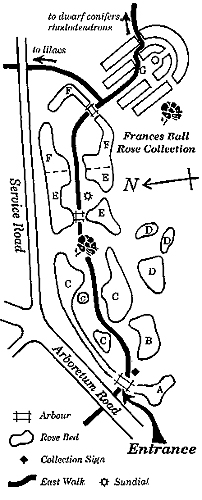Frances Ball Rose Collection

The Frances Ball Rose Collection displays aspects of the great variation of roses. Over 115 species and varieties of roses in this collection reveal much about the diversity and history of wild and cultivated roses.
Roses in Human Culture
The beauty and fragrance of roses have been part of our culture for thousands of years. The rose became part of the garden by 2660 B.C. in China and by 2300 B.C. in the Middle East. Roses were later part of trade along with spices and silk. They also provided products such as rose water which was worth more than its weight in gold to the ancient Greeks. The French empress Josephine (1763-1814) collected 250 different kinds of roses before she died. By crossing different species of roses and selecting some for unique traits, horticulturists have now produced over 20 000 cultivated varieties (cultivars)! Flower colour, flower size and plant form have been selected traits for centuries. Unfortunately, little attention was given to the health of the roses and thus many varieties are susceptible to disease. Modern horticulturists now breed roses with disease resistance in mind.
Wild Roses
All of the world's 100+ species of roses are native to the northern hemisphere. They vary from 40 cm high thickets of a tiny-leaved, drought-tolerant rose in Mexico to a 15 metre, huge-leaved, climbing rose in southwest China. Roses also vary in the habitats that they grow in. These include:
barren Canadian arctic tundra
scorching Arizona deserts
wet Louisiana swamps
dry Tibetan alpine slopes
windswept Scottish coasts
steamy Chinese forest valleys
Most roses, however, prefer a well-drained soil in open sunny conditions.
The genus name for roses is Rosa, and they are part of a very large family called Rosaceae or the rose family. Other members of this family are pear, apple, peach, apricot, strawberry, raspberry, crabapple, hawthorn, mountain ash, serviceberry and ninebark. All of these have a flower that is organized into five equally-shaped parts. To see some rose relatives, please visit the Rose Family Collection (just south of this collection).
The Frances Ball Rose Collection
Because The Arboretum uses as little pesticide as possible, we choose roses that are relatively hardy and need little, if any, spraying. Sections A-F (see map) represent different botanical classes of roses (i.e. roses in each section are closely related). Section G is a special group of cultivated roses.
